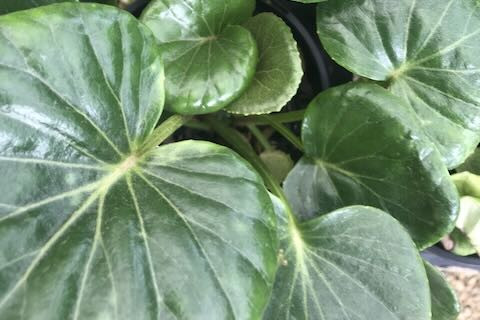
Covolvulus sabiatus
A useful tough cascading groundcover for dry banks and difficult areas once its established. Stays low and has a long flowering period


Attractive glossy foliage plant for shade, use as mass plantings for ground cover or grouped as specimens. Likes free draining soil in a cool position, very tough however once established, evergreen. Flowers unexciting, we usually chop off to feature the beautifully attractive leaves which can get to 20cm across.
Attractive glossy foliage plant for shade, use as mass plantings for ground cover or grouped as specimens. Likes free draining soil in a cool position, very tough however once established, evergreen. Flowers unexciting, we usually chop off to feature the beautifully attractive leaves which can get to 20cm across.
Data sheet
A useful tough cascading groundcover for dry banks and difficult areas once its established. Stays low and has a long flowering period
A beautiful new variety from our trial beds; flowers open white with a blush of pink on the underside, good stem length and vigour compared to other varieties. Grow in a cool damp spot on rich soil, winter deciduous as per other astrantia. Pinch out first flower to help roots develop.
More sun tolerant than other hydrangea varieties, but adaptable to part shade also. Beautiful deciduous variety with densely clustered white panicles in summer. Lovely feature plant behind perennials with deciduous viburnums, or grouped in woodland settings.
Robust and moisture tolerant species from Nepal, with attractive tall foliage and lime-green flowers. A stately elegant plant that can be cut to the ground in winter, flowers appear early summer alongside delphiniums, lupins, and campanula.
Old fashioned spreading grey foliage plant for amongst roses and perennials. Easy and dry tolerant.
A very beautiful plant with unusual white arching flower spikes. The foliage colours well in colder areas; both flowers and foliage are a delight for the flower arranger. Allow some room as plants will clump out substantially in a few years. Sun or dappled shade on moist soil.
Low growing variety with pink tinged foliage, bee attracting summer flowering.
One of the best Geranium pratense crosses , flowering all through summer with lovely dark blue flowers reminiscent of Geranium himalayense. Compact shape and long-flowering.
Pure white Japanese wind-flower for shaded woodland plantings. Not fast to establish but vigorous and low maintenance once fully grown. Mulch well, and trim lightly after flowering.
Low mounding variety that will trail over a wall or amongst rocks, likes drained drier soil types. Tasmanian native, very pretty plant and surprisingly tough, will withstand summer dry.
Attractive multicoloured variety, which starts off as lime green and cream then ages to pink or pale blue depending on soil pH. Morning sun only, best in part shade with good drainage.
Stunning double flowered paeonia requiring rich well drained soil in full sun, young plants often takes a year or two to establish but eventually form large clumps; we recommend removing first flowers to hasten establishment.
A wonderful Geum kept in circulation by Dennis Norgate; vibrant tangerine orange, repeat flowers throughout the year and non seeding.
Strawberry coloured blooms with for a sheltered morning sun position or shade, a beautiful variety that doesnt self seed as much as the usual types.
Lovely grape hyacinth for gardens or pots, vigourously clumping and easy, early spring flowering bulbs. Clump of flowered bulbs in each pot ready to plant.
Very pretty pale pink variety, mounding habit a bit over knee high for sunny position on drained soil. Trim after flowering to keep compact.60

Attractive glossy foliage plant for shade, use as mass plantings for ground cover or grouped as specimens. Likes free draining soil in a cool position, very tough however once established, evergreen. Flowers unexciting, we usually chop off to feature the beautifully attractive leaves which can get to 20cm across.